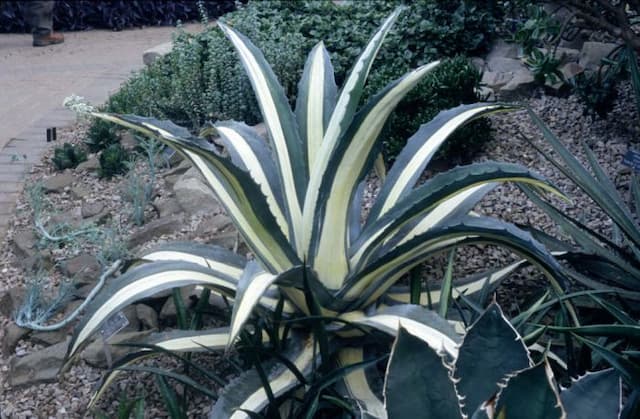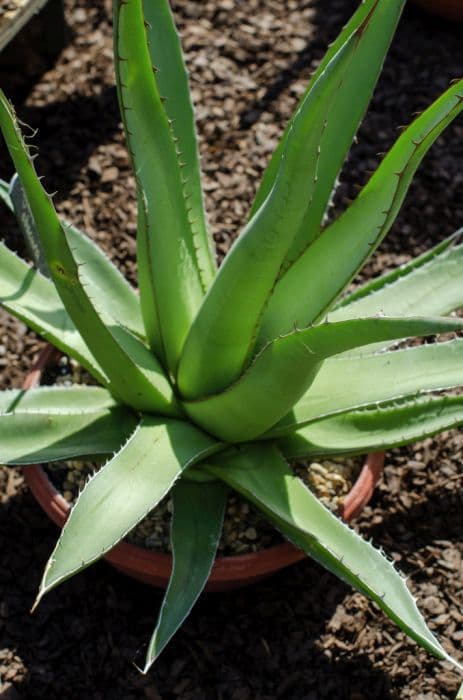Havard's agave Agave havardiana

ABOUT
A. havardiana is a succulent perennial with rosettes, up to 60cm high, of grey-blue-green leaves edged with sharp spines. When flowering stalks are produced, they are 2-5m high with scented white, yellow or yellow-green flowers in summer
About this plant
 Names
NamesFamily
Asparagaceae
Synonyms
Harvard Agave, Havard's Century Plant, Chisos Agave
Common names
Agave havardiana.
 Characteristics
CharacteristicsLife cycle
Perennials
Foliage type
Evergreen
Color of leaves
Blue-green
Flower color
Yellow
Height
3 feet (0.91 meters)
Spread
3 feet (0.91 meters)
Plant type
Succulent
Hardiness zones
5
Native area
Texas Coahuila
Benefits
 General Benefits
General Benefits- Drought Tolerance: Agave havardiana, commonly known as Harvard agave, is highly drought-resistant, making it ideal for xeriscaping and water-efficient gardening.
- Low Maintenance: Harvard agave requires minimal care once established, needing little watering or pruning, which saves time and effort for gardeners.
- Landscape Design: With its rosette of thick, fleshy leaves and potential for producing a tall flower stalk, Harvard agave can serve as a dramatic focal point in landscape design.
- Soil Erosion Control: The robust root system of Harvard agave helps to stabilize soil, preventing erosion in arid landscapes.
- Habitat for Wildlife: The flowers of Harvard agave provide nectar for pollinators, such as bees, bats, and hummingbirds, supporting local ecosystems.
- Longevity: Harvard agave plants have a long lifespan, reducing the need for frequent replanting and long-term gardening expenses.
- Cold Tolerance: Unlike many other agave species, Harvard agave has a relatively high tolerance for cold temperatures, making it suitable for a range of climates.
 Medical Properties
Medical Properties- This plant is not used for medical purposes.
 Air-purifying Qualities
Air-purifying QualitiesThis plant is not specifically known for air purifying qualities.
 Other Uses
Other Uses- Agave harvardiana fibers can be used for making ropes and twine because they are strong and durable.
- The sap of the Harvard agave can serve as a natural adhesive or glue due to its sticky consistency when dried.
- Leaves of the Harvard agave may be used to create a natural dye for fabrics, owing to the presence of certain pigments.
- Harvard agave can be cultivated as an ornamental plant in xeriscapes, which are landscapes that require minimal irrigation.
- The rosette form of the Harvard agave offers architectural interest in garden design, providing a sculptural element to rock gardens or desert landscapes.
- Larger leaves of the Harvard agave can be used as impromptu plates or serving platters in a naturalistic or outdoor setting.
- When the flowering stalk of the Harvard agave is cut and dried, it can be used as a natural walking stick or as part of rustic decor.
- Dried Harvard agave leaves can serve as fire starters due to their fibrous and inflammable nature when properly prepared.
- The thick, fleshy leaves of the Harvard agave can be used to create molds for small-scale casting projects due to their shape and rigidity.
- Harvard agave plants are sometimes used as barriers or living fences because of their large size and spiky leaves.
Interesting Facts
 Feng Shui
Feng ShuiThe Harvard Agave is not used in Feng Shui practice.
 Zodiac Sign Compitability
Zodiac Sign CompitabilityThe Harvard Agave is not used in astrology practice.
 Plant Symbolism
Plant Symbolism- Resilience and Adaptation: Agave havardiana, commonly known as Havard's century plant, is highly adapted to arid environments, symbolizing the ability to thrive under tough conditions.
- Longevity: The century plant, despite its name, typically lives 10 to 30 years, but it is symbolic of long life due to its slow growth rate and the lore that suggests it blooms once every century.
- Protection: With its robust, spiky leaves, the century plant represents defense and protection from external threats.
- Self-Sufficiency: Havard's century plant is drought-tolerant and capable of surviving with minimal resources, symbolizing self-reliance and independence.
- Patience: As the century plant takes many years to flower, it symbolizes patience and the idea that some things are worth waiting for.
 Water
WaterHarvard's agave should be watered sparingly, as it is highly drought tolerant. During the growing season in spring and summer, water the plant deeply approximately once every three weeks, providing it with about 1-2 gallons depending on the size of the plant and the dryness of the soil. In the fall and winter, reduce watering to once every four to six weeks, ensuring the soil is completely dry between waterings to prevent root rot.
 Light
LightHarvard's agave thrives in full sun and should be situated in a spot that receives direct sunlight for at least six hours per day. An outdoor location that offers bright, unfiltered sunlight is ideal for this plant. If grown indoors, place it near a south-facing window to ensure it receives ample light.
 Temperature
TemperatureHarvard's agave is hardy and can tolerate temperatures down to about 0 degrees Fahrenheit but grows best in climates where temperatures range between 70 to 90 degrees Fahrenheit. It can withstand high summer temperatures well above 100 degrees Fahrenheit, making it suitable for various arid environments.
 Pruning
PruningHarvard's agave does not require regular pruning, but occasional maintenance may be necessary to remove any damaged or dead leaves. Pruning should be done carefully, using clean, sharp tools to prevent injury to the plant. The best time to prune is in the spring or early summer when the plant is actively growing.
 Cleaning
CleaningNot needed
 Soil
SoilHarvard Agave prefers a well-drained soil mix, consisting of one part potting soil, one part coarse sand, and one part perlite or pumice. The ideal soil pH for Harvard Agave should be slightly acidic to slightly alkaline, between 6.0 and 7.5.
 Repotting
RepottingHarvard Agave should be repotted infrequently, only when it has outgrown its current pot, which may occur every 3 to 5 years. These plants prefer to be pot-bound and do not need annual repotting.
 Humidity & Misting
Humidity & MistingHarvard Agave thrives in low humidity conditions. It is well-suited to dry environments and does not require high humidity levels to grow successfully. That makes it ideal for arid and semi-arid climates.
 Suitable locations
Suitable locationsIndoor
Use well-draining soil, place in bright light, minimal water.
Outdoor
Full sun, well-drained soil, protect from extreme cold.
Hardiness zone
5-9 USDA
 Life cycle
Life cycleAgave havardiana, commonly known as Harvard's agave or Havard agave, begins its life cycle as a seed germinating in well-drained, sandy soil, often in the rocky terrains of the Chihuahuan Desert. After germination, it enters a long juvenile period, during which it develops a rosette of thick, fleshy leaves designed to store water in its arid environment. The plant grows slowly, remaining in this vegetative state for many years—commonly up to several decades—until it reaches maturity. Upon maturity, it produces a tall, flowering stalk, which can grow several meters high and produces numerous yellow to pale-green flowers, attracting pollinators such as bats, bees, and birds. After this single massive flowering event, which may last a few months, the agave allocates all its energy to reproduction and then dies. The seeds disperse, often with the assistance of the wind or animals, completing the life cycle as they give rise to new plants.
 Propogation
PropogationPropogation time
Spring to Summer
Propogation: Agave havardiana, commonly known as Harvard agave, is best propagated by using offsets, also called "pups," that naturally grow around the base of the parent plant. These pups can usually be found emerging from the soil near the mother plant during the active growing season, typically in the spring or early summer. To propagate Harvard agave using a pup, it should be carefully removed from the mother plant with a clean, sharp instrument, ensuring a portion of the root is attached. The pup should then be allowed to dry for a few days to form a callous on the cut surface, which helps prevent rot. After callousing, the offset can be planted in a well-draining cactus or succulent mix, placed in bright, indirect light and watered sparingly until it establishes roots, which usually takes several weeks. This method is popular due to its simplicity and effectiveness in producing new, genetically identical plants.









